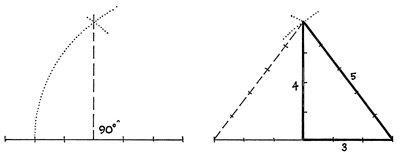Průzkumy památek 2020, 27(1):143-156 | DOI: 10.56112/pp.2020.1.11
Ars sine scientia? Practical Geometry of the Medieval Painting

The ambivalence of the construction order and free imagination are first viewed upon from the perspective of the practical auxiliary geometry - from the squaring and triangulation adopted from architects to the setting of the visual field format. Nevertheless, the author emphasises that the composition of the visual field represents - unlike the mechanical monitoring of golden ratios and further proportional outlines - a system of a higher order, in which the linear outline remains to be just one of the aspects, the initial stage of the work's origin. He further highlights the knowledge of perspective in the High Middle Ages as well as its rejection (unwanted optical shortcuts!) in favour of the 'relative space'. The space is then broken in the visual field on different foundations - an autonomous visual world that also includes the element of play is shaped by an intuitive usage of internal geometric rhythms.
Keywords: composition - squaring - triangulation - compasses - diagonal - perspective
Published: June 15, 2020 Show citation
References
- J. S. Ackerman, "Ars sine scientia nihil est" - Gothic Theory of Architecture at the Cathedral of Milan, in: The Art Bulletin, vol. 31, No. 2, New York 1949, s. 84-111.
 Go to original source...
Go to original source... - P. Frankl, The Secret of the Mediaeval Masons, in: The Art Bulletin, vol. 27, No. 2, New York 1945, s. 46-60.
 Go to original source...
Go to original source... - W. Tatarkiewicz, Estetyka średniowieczna. Wrocław - Warszawa - Kraków 1962.
- O. von Simson, The Gothic Cathedral. London 1956.
- C. Cennini, Il libro dell'arte (ed. riveduta e corretta sui codici per cura di Renzo Simi). Lanciano 1913.
- C. Cennini, Kniha o umění středověku. Praha: Vladimír Žikeš 1946.
- A. A. Tic, Někotoryje zakonomernosti kompozicii ikon Andreja Rubleva i jego školy, in: Drevněrusskoje iskusstvo 15. - nač. 16. vekov. Moskva 1963, s. 23-52.
- M. Bohatec, Skryté poklady. Praha: Artia 1970.
- G. R. Dodwell ed., Theophilus, Presbyter, De diversis artibus. The Various Arts. London - New York 1961.
- M. Restle, Die byzantinische Wandmalereien Kleinasiens I. Recklinghausen 1967.
- P. Hetherington, The Painter's Manual of Dionysius of Fourna. London 1974.
 Go to original source...
Go to original source... - R. Pleiner ed., Pravěké dějiny Čech. Praha: Academia 1978.
- J. Mašín, Románská nástěnná malba v Čechách a na Moravě. Praha 1954.
- E. Bachmann ed., Romanik in Böhmen. Geschichte, Architektur, Malerei, Plastik und Kunstgewerbe. München 1977.
- B. Gebauer - T. Kersting - H. Nothdurfter - O. Emmenegger, St. Prokulus, Naturns: Archäologie, Wandmalerei. Bozen: Landesdenkmalamt Bozen 1990.
- F. Henry, L'art irlandais I. Éditeur Zodiaque 1963.
- K. Stejskal, Pasionál Přemyslovny Kunhuty. Praha: Odeon 1975.
- H. R. Hahnloser, Villard de Honnecourt. Wien 1935.
- B. Bossuquet, A History of Aesthetics. London 1892.
- G. Černušák, Dějiny evropské hudby. Praha - Bratislava: Panton 1964.
- Ch. Bouleau, Charpentes, la géométrie secrète des peintres. Paris: Éditions du Seuil 1963.
- Viollet-le-Duc, Dictionnaire raisonné de l'architecture française du XIe au XVIe siècle, VIII. Paris 1858-1868.
- A. Novák, Corpora ordinata et continuata. Witelova optika jako pramen k technice a kompozici malby 13. a 14. století, in: Technologia artis 3, Praha: Obelisk 1993, s. 19-26.
- J. Pešina, Tektonický prostor a architektura u Giotta. Praha 1945.
- J. Pešina - J. Mannsbarth, Studie k problematice prostoru v české malbě druhé poloviny 14. století, in: Památky archeologické 43, 1948, s. 20-45.
- B. V. Raušenbach, Prostranstvennyje postrojenia v drevněrusskoj živopisi. Moskva 1975.
- L. F. Žegin, Jazyk živopisnogo proizvedenia. Moskva 1970.
- L. F. Žegin, Jazyk malířského díla. Praha: Odeon 1980.
- L. Berti. Santa Croce. Edice Treasures of Christian Art. Bologna 1967.
- V. Dvořáková, Karlštejnské schodištní cykly. K otázce jejich vzniku a slohového zařazení, Umění IX, 1961, s. 109-171.
This is an open access article distributed under the terms of the Creative Commons Attribution-NonCommercial-ShareAlike 4.0 International License (CC BY-NC-SA 4.0), which permits non-comercial use, distribution, and reproduction in any medium, provided the original publication is properly cited. No use, distribution or reproduction is permitted which does not comply with these terms.



